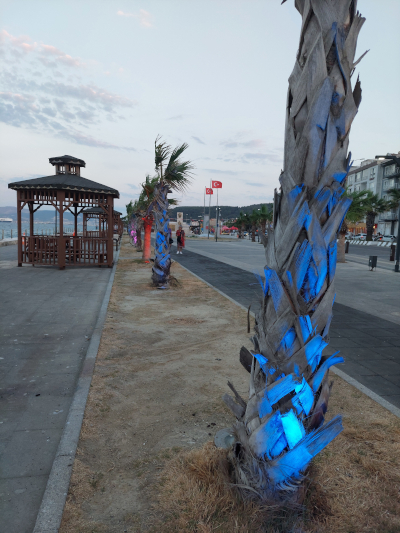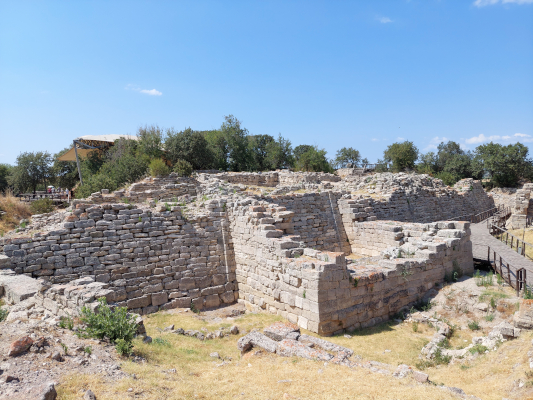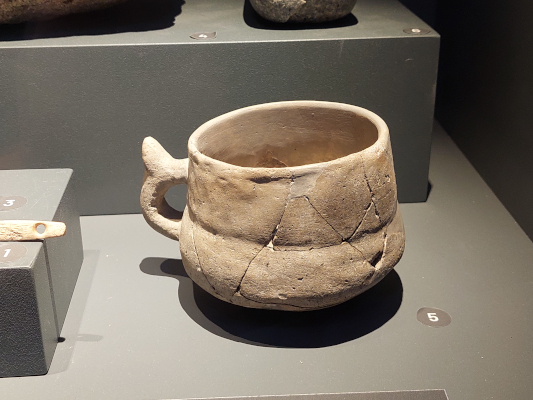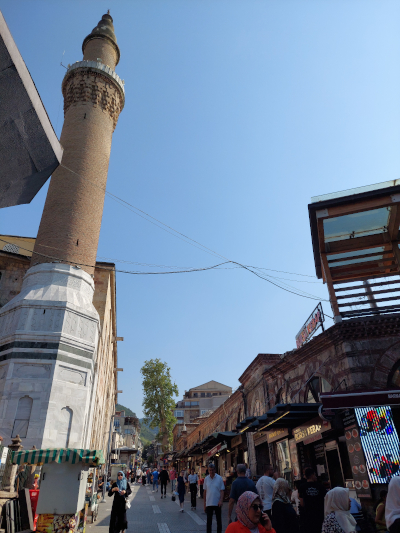Cities along the Dardanelles
We crossed the Dardanelles from the European side to Çanakkale from Eceabat, but ferries also depart from Kilitbahir. Eceabat is a great place to watch ships passing through the Dardanelles, from small pavilions along the promenade, you can observe vessels of all kinds — from cargo ships and ocean liners to ferries and smaller boats — traversing the strait. In the evening, the trunks of the palm trees along the seaside promenade of Eceabat are illuminated in different colors, adding even more atmosphere to the town. The name Kilitbahir means “Lock of the Seas,” and the fortress here was built by Ottoman Sultan Mehmed II to control the strait. Cars can be transported by ferry on any of the routes. In Çanakkale stands the statue of the Trojan Horse that was built for a movie production and later gifted to the city.

Eceabat seaside promenade
The Ruins of Troy
Troy lies about half an hour’s drive south of Çanakkale. A combined ticket grants access to both the ruins and the museum. The city’s ruins consist of multiple layers, each built during a different historical period. Visitors can walk among the walls — we spent more than two hours exploring the ruins. At the entrance, a wooden horse greets visitors, and nearby in a garden stand large amphorae, their pointed ends in the ground. Next, you can walk among walls from Roman-era Troy, then reach a wall built of mudbrick. After that come the stratified layers of the city, where you can see three levels at once. The ramp leading to the palace and the palace walls follow. Here and there, informational panels are complemented by colorful reconstruction drawings. The last major ruin is the theater, built for Emperor Hadrian’s visit, and finally, you reach the ongoing excavation area.

The walls of Troy from the Roman period
Troy Museum
In the Troy Museum, you can see not only artifacts from Troy itself but also finds from other archaeological sites. A significant part of the museum is dedicated to the Bronze Age — for example, you can see a five-thousand-year-old cup. One floor is devoted to the heroes from Homer’s Iliad; some even “speak” on interactive screens.

The cup which is least five-thousand-year-old
The appeal of the museum is not limited to the displayed objects — the numerous maps greatly enrich the exhibition. They show, for instance, which regions Troy traded with, where other Bronze Age cities in Anatolia were located, and which Greek city-states fought against Troy in the Trojan War.
Heading East!
After exploring the Dardanelles region, we headed east. On our way to Cappadocia, we stopped in Bursa. Bursa lies at the foot of Mount Uludağ, surrounded by mountains on the other side as well, facing the Sea of Marmara. The city, with its Eastern ambiance, has a huge bazaar — with entire sections dedicated to furniture, textiles, and gold jewelry. But the most interesting find was a dessert bought from a street vendor next to the bazaar: hurma tatlısı, a Bursa specialty made with coconut and soaked in sugar syrup. The city also has a former caravanserai, located not far from the bazaar.

The area around the bazaar of Bursa